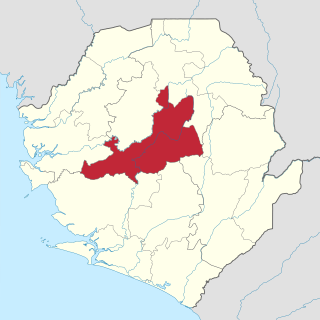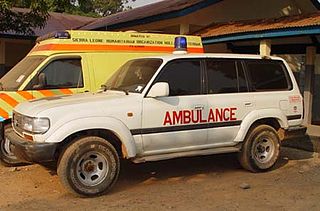Related Research Articles

Sierra Leone is a country in West Africa with a North Atlantic Ocean coastline to the west. It lies on the African Plate. The country's main geographical features include wooded hill country, an upland plateau, and mountains in the east. The highest peak is Mount Bintumani, which is 1,948 meters (6,391 ft) above sea level. The coastline has a belt of mangrove swamps. Freetown, the nation's capital city, has one of the world's largest natural harbours. The Rokel River is the largest river in Sierra Leone. It is 400 kilometres (250 mi) long and has a basin with a total area of 10,622 square kilometres (4,101 sq mi).

There are a number of systems of transport in Sierra Leone, a country in West Africa, which possess road, rail, air and water infrastructure, including a network of highways and several airports.
Pepel is a coastal town in the Port Loko District in the Northern Province of Sierra Leone.

Makeni is the largest city in the Northern Province of Sierra Leone. The city is the capital of Bombali District, and is the economic center of the Northern Province. Makeni is the fifth largest city in Sierra Leone by population. The city of Makeni had a population of 85,116 in the 2021 census. Makeni lies approximately 110 miles east of Freetown. Makeni is home to the University of Makeni, the largest private university in Sierra Leone.

The Eastern Province is one of the four provinces of Sierra Leone. It covers an area of 15,553 km2 and has a population of 1,641,012. Its capital and administrative centre is Kenema. Eastern Province, the centre of the country's diamond mining industry, is very mountainous and has two ranges, the Gola Hills and the Loma Mountains.

The Siaka Stevens National Stadium, commonly known informally as the National Stadium, is the national stadium of Sierra Leone, located in the capital city of Freetown. It is used mostly for football matches and it also has athletics facilities. It is the largest and main stadium in Sierra Leone and has a capacity of 45,000. The stadium serves as the exclusive home of the Sierra Leone national football team, known as the Leone Stars.

Tonkolili District is a district in the Northern Province of Sierra Leone. Its capital and largest city is Magburaka. The other major towns include Masingbi, Yele, Mile 91, Bumbuna, Yonibana, Matotoka. Mathora, Magbass and Masanga. Tonkolili District is home to the largest sugar factory in Sierra Leone, and one of the largest sugar factories in West Africa, that is located in the town of Magbass. Tonkolili District had a population of 530,776. The district occupies a total area of 7,003 km2 (2,704 sq mi) and comprises eleven chiefdoms.

The Sierra Leone Government Railway operated in Sierra Leone from 1897 to 1974. It was unusual in that it formed a national railway system constructed solely to a 2 ft 6 in narrow gauge, whereas in other countries, gauge of such a narrow width was usually confined to feeder railways.
The Lytton First Nation, a First Nations band government, has its headquarters at Lytton in the Fraser Canyon region of the Canadian province of British Columbia. While it is the largest of all Nlaka'pamux bands, unlike all other governments of the Nlaka'pamux (Thompson) people, it is not a member of any of the three Nlaka'pamux tribal councils, which are the Nicola Tribal Association, the Fraser Canyon Indian Administration and the Nlaka'pamux Nation Tribal Council.
Lunsar is a town in Marampa Chiefdom, Port Loko District in the Northern Province of Sierra Leone. It is the largest town in Port Loko District by population. The Britannica estimate of the population of Lunsar is 36,108. The town is one of the main commercial and business hub in the North of Sierra Leone. Lunsar lies approximately 50 miles east of Freetown and about 18 miles south-east of the district capital of Port Loko. The inhabitants of Lunsar are largely from the Temne ethnic group.
Railway stations in Sierra Leone include:
Bradford is a town in western Sierra Leone located near the capital of Sierra Leone, Freetown.
Boajibu is a town in Kenema District, in the Eastern Province of Sierra Leone. It is the Chiefdom Headquarters of the Simbaru Chiefdom. The current Paramount Chief of Simbaru Chiefdom is P.C Madam Mamie G. Gamanga. The present population of Boajibu is about 10,956 according to the 2023 Population and Housing Census of Sierra Leone.
The Bagla Hills are located in eastern Sierra Leone within Gola Rainforest National Park, created in 2010, near the border with Liberia. The site has been the subject of controversy between developers and conservationists, as it contains a large iron ore deposit. The Bagla Hills are one of the habitats of the endangered Jentink's duiker.
Kongo is a small town in Grand Cape Mount County, Liberia, on the border with Sierra Leone. It served an iron ore mine, with a narrow gauge railway, which are both currently out of use. There are similar iron ore deposits across the Mano River which forms the border between the two countries.
Tagrin Point is the proposed location of a deep water port to replace the older and shallower port of Port Pepel in Sierra Leone. It would be connected to existing and new iron ore mined by an upgraded railway line converted to standard gauge.

The mining industry of Sierra Leone accounted for 4.5 percent of the country's GDP in 2007 and minerals made up 79 percent of total export revenue with diamonds accounting for 46 percent of export revenue in 2008. The main minerals mined in Sierra Leone are diamonds, rutile, bauxite, gold, iron and limonite.

Healthcare in Sierra Leone is generally charged for and is provided by a mixture of government, private and non-governmental organizations (NGOs). There are over 100 NGOs operating in the health care sector in Sierra Leone. The Ministry of Health and Sanitation is responsible for organizing health care and after the end of the civil war the ministry changed to a decentralized structure of health provision to try to increase its coverage.

The National Railway Museum is a railway museum in Freetown, Sierra Leone. The museum was opened in 2005.
Moctezuma volcanic field is a volcanic field in Sonora, Mexico. The towns of Moctezuma, La Junta, Casa Grande, San Clemente de Terapa, Tepache, El Llano and Divisaderos lie in the area.
References
- ↑ "SIERRA LEONE RAILWAY". Railways Africa. Retrieved 2010-11-09.